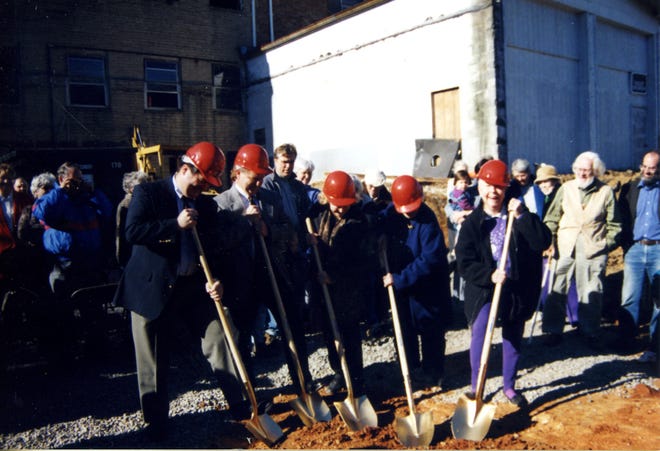Black Mountain Center for the Arts takes shape

This is the second of a four-part series documenting the evolution of the Black Mountain Center for the Arts in celebration of its 20th anniversary.
BLACK MOUNTAIN - Big change only happens with a corresponding effort. The birth of the Black Mountain Center for the Arts was no exception.
By the time Betty Tyson purchased the property at 225 W. State Street that had once been City Hall, the building had been in disuse for years and all but abandoned. There was talk of demolishing the structure.
Tyson (1914-2009), who made the purchase anonymously, was a founder of Tyson Furniture and a community leader. She, along with a like-minded group of prominent citizens, helped fund the purchase and rally support for a vibrant community arts center. Records show an original organizing committee as early as 1993, and dozens of board members and advisers in the years leading to the official opening.
“I was skeptical that it (BMCA) would happen,” says Tyson’s son, Joe, recollecting those early years. “In addition to raising the capital necessary to purchase and renovate the building, there would be a need for ongoing financial support. It was a very risky venture in such a small town, but this is a remarkable town that supports many charitable efforts in addition to the arts center, so in the end, they were right.”
Joining Tyson on the original Capital Campaign committee were Gay Currie Fox (1921-2018), who left a mark on Black Mountain from Lake Tomahawk to the Recreation and Parks Department to the MLK Breakfast and Warren Wilson Presbyterian Church; Ben Holden (1918-95), who served as the president of Warren Wilson College from 1971-86, was a former executive at Yale University and worked behind enemy lines in Indo-China during World War II; and Ruth Bell Graham (1920-2007), author, poet, recipient of the Congressional Gold Medal and wife of world-reknown evangelical Billy Graham.

Together with a team that included board chair Wendy Craig, Billy Edd Wheeler, Will Kennedy, Sara Marcia Rafter, Per Reich, Tom Tracy and many others, this powerful group spread out among the community and made their pitch to gather the support and funds necessary to create the arts center.
“Our message was that this was something created by the community to serve the community,” recalls Tom Tracy, who at that time along with his wife Libba owned Goodness Glazes, a local paint-on-pottery store located near My Father’s Pizza. “People responded.”
“We went to lots of public meetings and gave lots of talks. We spoke about it wherever we could: to Rotary and Kiwanis, at gatherings at the high school, in people’s living rooms, over coffee, anywhere we could get a group of people together.”
“It was a lot of work,” said Tracy. “And it took a long time, but everyone loved the idea of a community arts center.”
In addition to the “boots on the ground” approach, Goodness Glazes hosted a One Tile at a Time fundraiser, the results of which occupy an entire wall on the lower level. The arts center recently mounted a historical display adjacent to the beautiful tile wall in honor of our 20th anniversary.
It was during that initial fundraising effort, according to Tracy, that the board decided to hire a fundraising consultancy out of Winston-Salem, and with their recommendations, the effort gained momentum with federal, state and local grants. By March 1995 nonprofit 501(c)(3) status was attained. The efforts of the Capital Campaign committee paid off because in the end, they raised $1.2 million, and the Black Mountain Center for the Arts was closer to becoming a reality.
By 1996, Raleigh architect Steven Shuster of Clearscapes and Asheville architect Steve Farrell of Farrell+Hargrove were hired, and the committee now volunteered their time to facilitate the renovation of the building. A director needed to be hired, so they organized to find the right person for the job. Initially, Gary Semlak and then Ed Pauley filled the position, but soon Gale Jackson, executive director of Indiana’s Jasper Community Arts Commission, moved with husband Dennis Jackson in February 2000 to see the renovation through its final stages.
The arts center opened its doors Oct. 19, 2000.
For the next 20 years, Jackson and the BMCA staff, led by a community-centered board of directors, worked to build an arts center supported by the community, filled with events for the community that included a wide range of classes, concerts, theater, a clay studio and an art gallery. Given the thousands of people touched by the Black Mountain Center for the Arts over the years, the reality has exceeded the vision of its founders.
Part 3 of this series will focus on the growth of the Arts Center over the years and its major accomplishments.
The BMCA is open from 10 a.m.-5 p.m. Monday through Friday. For more information call 828-669-0930 or visit blackmountainarts.org.